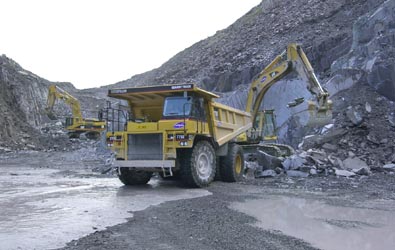|
|
ENGLISH STONE FORUM |
|
.
|
Home
> Issues > Building stone industry in Britain
1
| 2|3&4
| 5 | 6
| 7 | 8
| 9 | 10
| 11
|
|
|
2.
Quarrying and quarrying techniques
Britain's dimension stone quarrying industry is one in which a blend of traditional and modem techniques are still used to produce stone for building purposes. Even the hardest stone needs to be carefully removed from the quarry and prepared for use using extraction techniques that will not cause damage or weakening of the stone. This has ensured that tried and tested traditional methods of stone extraction are still widely used. Initial extraction is still commonly carried out by simple channelling using picks and power drills and percussive splitting (plug & feathers) or by sawing of the block from the bed. Extraction by blasting techniques is rarely used in most sedimentary dimension stone quarries and only sparingly in the harder igneous and metamorphic slate quarries. The strength and durability of stone is affected by many natural factors such as jointing, cleavage, bedding etc. and quarrying companies have generally learned, by experience, to take full advantage of such factors in the production process. A knowledge of the size and orientation of any major joint sets, for example, particularly in igneous rocks which have no natural bedding planes, is particularly relevant. Natural joints are produced by stress release as the rock is exposed at the earth surface, and tend to have discrete and predictable regional trends. They cause the rock to split naturally into relatively regularly sized blocks. Such joint patterns can have significant effects on the way in which a quarry operator develops the quarry face. In contrast, while jointing is also often a common feature of sedimentary rocks, their characteristically bedded nature also exerts control on the size of block which can be produced. The techniques used to initially extract stone blocks have tended to exploit such natural lines of weakness. |

Penrhyn slate quarry Gwynedd |
Changing techniques in the construction industry have lead to different needs for stone, principally since the 1930's the increasing use of thinly slabbed stone for cladding on prefabricated metal frameworks (Kempe 1983). Although these demands have necessitated the setting up of new standard tests to ensure the suitability of the many different stones now available to the expanding world market, quarrying production techniques still largely follow traditional techniques changing only in the scale of production. |
| 1 | 2 | 3&4 | 5 | 6 | 7 | 8 | 9 | 10 | 11 | |
| . |
|